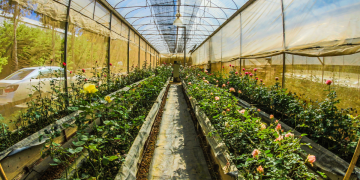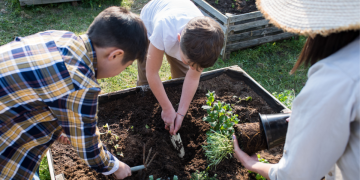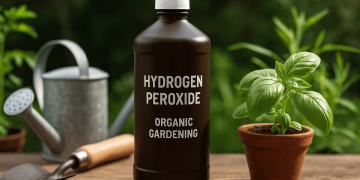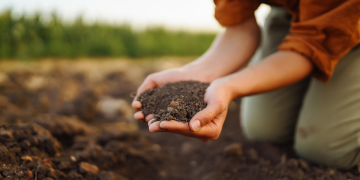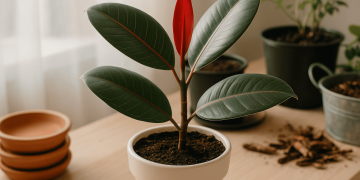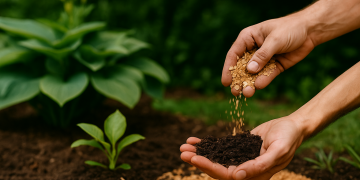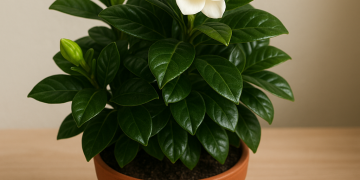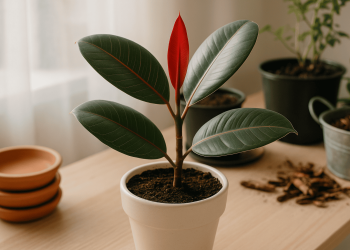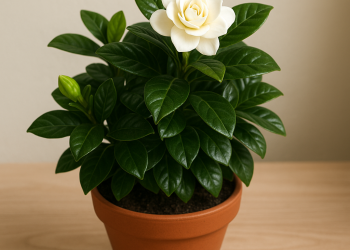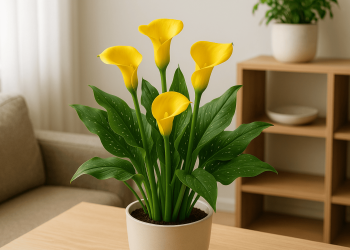The true foundation of any garden isn’t the plants you see above ground, but the soil that sustains them below. A healthy soil works like a well-stocked pantry and a reliable water tank at once: it delivers nutrients, air, and moisture in the right proportions. When the soil is weak, roots struggle, and deficiencies show up fast in leaves and growth. If you’re planning to start a garden, understanding your soil’s composition, and how to improve it, can be the difference between fragile plants and a thriving, resilient oasis.
Table of Contents
ToggleDifferent Types of Soil
Clay Soils
Not all soils behave the same, and clay is the perfect example. This “heavy” soil type is made of roughly 25% clay, which makes it fertile but also stubborn to work with. Because its particles are so tightly packed, water drains very slowly and the ground stays cold longer in spring. In summer, it hardens and cracks, like a dried-up riverbed. Gardeners often find it tricky to manage: while it can store plenty of nutrients, too much watering quickly turns it into a soggy, airless mess.
Sandy Soils
If clay is stubborn, sandy soil is the opposite: light, loose, and fast-draining. Think of it like a giant colander, water slips through almost as soon as it arrives. This makes it quick to warm up in spring, giving plants an early start. The downside is that nutrients wash away just as fast, leaving the soil poor and often slightly acidic. Without extra care, plants in sandy soil can go hungry no matter how much you feed them.
Silty Soil
Silt sits halfway between sand and clay, combining traits of both. Its fine particles hold more water than sand, and its natural fertility makes it a favorite for many crops. Imagine the soft, powdery soil you find along riverbanks, that’s silt: smooth, rich, and easy to work with when moist. But there’s a catch. Once it dries, it compacts quickly, turning tough and difficult to till, so good drainage and care are essential.
Loamy Soil
Loam is often called the gardener’s dream soil, and for good reason. It’s a balanced mix of sand, silt, and clay, combining the best of each: soft to work with, quick to drain yet able to hold enough moisture, and packed with nutrients. Thanks to its natural content of humus, calcium, and a stable pH, loam creates the perfect buffet for plant roots. The result? Strong growth and generous harvests, whether you’re planting vegetables or flowers.

Here’s a quick comparison of the main soil types, so you can see at a glance what each one offers and which plants thrive best in them:
| Soil Type | Texture | Drainage | Nutrients | Best For |
|---|---|---|---|---|
| Sandy | Gritty, loose | Fast, dries quickly | Low, washes away easily | Carrots, potatoes |
| Loamy | Balanced mix | Well-draining | Rich and fertile | Most vegetables & flowers |
| Clay | Heavy, sticky | Slow, holds water | High, but hard to access | Leafy greens, moisture-loving plants |
| Silty | Smooth, soft | Moderate | Good, fertile | Grasses, vegetables, ornamentals |
💡 Gardener’s Tip:
Add organic matter to any soil type, it’s like giving it a health boost that improves structure, drainage, and fertility all at once.
What Does Healthy Garden Soil Look Like?
Regardless of whether your garden sits on sand, clay, or loam, truly healthy soil always shares the same traits:
- High fertility
- Good drainage
- Easy to till and work
- A deep, rich topsoil layer
- Fewer weeds competing for space
Think of healthy soil as a mini-ecosystem: earthworms tunnel through it, microbes break down organic matter, and nutrients are constantly being recycled for plant roots. Since most plants depend on the topsoil, keeping this layer aerated and full of life is the real secret to a thriving garden.
Test and Balance Your Garden Soil pH
The pH of your soil works like a chemical gatekeeper: it decides which nutrients plants can actually absorb. Some crops prefer slightly acidic conditions, others thrive in more alkaline soil—but if the balance is off, even the richest compost won’t help.
If your soil is too acidic (below 6.0) or too alkaline (above 7.5), roots struggle to take in nutrients properly. That’s why testing your soil is the first step before planting.
How to test soil pH:
-
Get a simple pH meter or home test kit.
-
Collect samples from different spots in your garden.
-
Mix them together for accuracy, then test.
-
For most vegetables and ornamentals, the sweet spot is pH 6.0–7.0.
How to Fix if the pH is Imbalanced?
Adjusting soil pH is straightforward with the right amendment. Here’s a quick guide:
| Soil Condition | Amendment to Add | Application Tip |
|---|---|---|
| Too acidic (pH < 6) | Lime or wood ash | Mix into the top 6 inches of soil, then retest after a few months |
| Too alkaline (pH > 7.5) | Sulfur or iron sulfate | Mix into the top 6 inches of soil, then retest after a few months |
How to Check Your Garden Soil Drainage
Good drainage is as important as good nutrition: without it, roots can drown just like people in a flooded basement. A simple test can reveal how your soil handles water.
Drainage Test (easy method):
-
Dig a hole about 12 inches deep.
-
Fill it with water and let it drain completely.
-
Refill the hole and time how long it takes to empty.
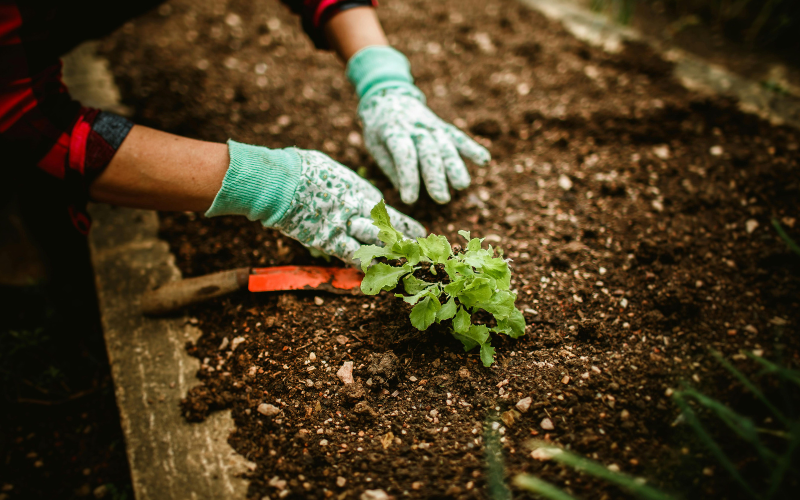
Results:
-
⏱ 1–2 hours → Ideal drainage.
-
⚡ Less than 1 hour → Drains too fast (likely sandy soil).
-
🐌 More than 2 hours → Drains too slowly (likely clay soil).
Knowing this helps you decide whether to amend your soil or simply choose plants that thrive under those conditions.
Best Organic Soil Amendments for Garden Soil
You can’t swap out your garden’s soil type, but you can definitely upgrade it. Organic matter works like vitamins for the earth: it boosts sandy soils so they hold more water and nutrients, and it loosens heavy clay, improving aeration and drainage. It even helps clay soil warm up faster in spring.
Great organic amendments for garden soil:
-
Bark mulch, straw, or shredded leaves
-
Well-rotted manure
-
Wheat straw
-
Compost
⚠️ Important
Never use plant material treated with herbicides, those residues can linger in the soil and harm your crops.
Inorganic Amendments for Garden Soil
Organic matter feeds the soil, but inorganic amendments help shape its structure. Materials like perlite, sand, or vermiculite work like tiny spacers between soil particles, improving aeration and porosity.
For example, clay and silt tend to compact, while sand drains too quickly. Mixing in the right amendment, often alongside organic matter, balances these extremes.
Inorganics work best when paired with organic matter, giving soil both structure and nutrition.
| Soil Type | Recommended Amendments |
|---|---|
| Sand | Compost, peat moss, mulch, bentonite clay |
| Clay | Compost, organic matter |
| Silt | Sand, compost (for drainage) |
| Loam | Annual organic amendments |
| Chalk | Mulch, compost, manure, leaf mold |
| Peat | Sand, compost, mulch (for drainage) |
Build your Healthy Garden Soil
Soil is the foundation of every garden, it determines how strong your plants grow and how abundant your harvest will be. Choosing the right type of soil is just the beginning; the real magic happens through regular testing and steady improvements with amendments.
Think of it as a long-term investment: building rich, fertile soil doesn’t happen overnight, but with patience, each season adds new life to the ground. The reward is worth it—a vibrant garden bursting with vegetables, flowers, and resilience.

